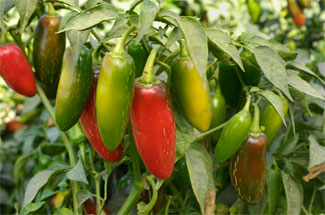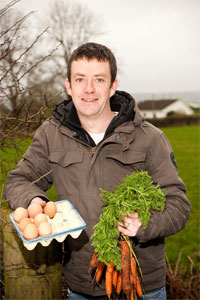Grow it Yourself - November
 It was World Food Day last month and as I always do with these vast global events, I tried to think about it down at the only level that makes any sense to me – my vegetable patch. One of my main motivations for growing my own food is that supermarkets just don’t provide any real variety when it comes to fruit and vegetables.
It was World Food Day last month and as I always do with these vast global events, I tried to think about it down at the only level that makes any sense to me – my vegetable patch. One of my main motivations for growing my own food is that supermarkets just don’t provide any real variety when it comes to fruit and vegetables.
There is an assumption that because our world is so small now, we have access to a vast array of new and exotic vegetables from all over the globe. In fact, ever more powerful trans-national supermarkets are forcing food producers in to the strait-jacket of mono-culture – producing higher yields of ever-decreasing varieties of vegetables.
What does this really mean? Whereas two decades ago you could find 10 or 15 varieties of apples or tomatoes in a supermarket – now there are just a couple. And in all likelihood they will be same varieties available in a supermarket in Spain or America or Asia. Almost all (90% plus) of the apples on sale in supermarkets around the world are of just 5 varieties. 75% of the world's agricultural diversity has been lost in the last century according to the UN Food and Agriculture Organisation.
 This tragic blandness suits retailers who are only interested in bulk selling, but its terrible for bio-diversity, taste and variety. The beauty of the veg patch is the diversity it offers us. We have at our fingertips a smorgasbord of varieties for each veg that we can dip in to each season.
This tragic blandness suits retailers who are only interested in bulk selling, but its terrible for bio-diversity, taste and variety. The beauty of the veg patch is the diversity it offers us. We have at our fingertips a smorgasbord of varieties for each veg that we can dip in to each season.
We can grow vegetables that you rarely get at all in a supermarket like kohlrabi, artichokes or Florence fennel. We can grow a variety of tomato that we know to be particularly tasty (the revelation for me this year was Sungold – the fizzbomb of the tomato world). In short, we are empowered.
Things to do this month - November
To Do
Do not leave beds bare for the winter – sow a green manure, or cover with a thick layer of manure/compost and then black plastic or straw. This will return nutrients to the soil, keep the worst of the weather off it, suppress weeds and prevent leaching of nutrients.
‘Earth up’ or tie up vegetables such as cabbage, cauliflower and Brussels sprouts. Divide up your rhubarb if you want to propagate, and cover it with a thick mulch of manure. Prune apple trees. Mulch fruit bushes. Take cuttings of currant bushes from current season’s wood.
Sow
Sow broad beans outside now for an early crop next spring. To avoid rotting before germination, make small newspaper cups and germinate them indoors first. Next summer’s garlic does best if it’s planted before Christmas – plant outdoors in well prepared soil in a sunny spot.
Though I have to admit I never bother with them, some varieties of onion can over-winter and will be ready to harvest in early summer.
Harvest
Continue to harvest perpetual spinach, cabbage, cauliflower, potatoes, swede, parsnips, apples, pears. Start harvesting leeks, winter cabbage, kale, artichokes, Brussels sprouts. Time to lift carrots and turnips or at least cover them with a good layer of straw to protect them from frost damage.
Recipe of the Month – Rabbit Stew
Our red setter has a tendency to come home from winter walks carrying a rabbit – a quick skinning and some knife work, and you’ve a cracking winter stew in prospect. Many butchers will source wild rabbit for you if you ask. Since rabbit is a very lean meat, the bacon bring the necessary fat to the equation.
Serves 4.
Ingredients
• 250g streaky bacon
• 1 wild rabbit, skinned and jointed (1.5-1.8kg)
• Chopped vegetables and herbs – whatever your veggie plot has to offer you: veg (a few cloves of garlic, a large onion, three good sized carrots and a stalk of celery) and herbs
• 600ml stock and glass of white wine
Directions
Cut the bacon in to cubes and fry it in some oil – remove to a casserole dish. Fry the rabbit pieces until golden brown. Add to the casserole. Throw the veggies in to the pan and get the juices from the cooked meat all over them before putting them in with the meat.
Deglaze the pan with the stock and pour that in to the casserole with the wine. Add the chopped herbs and season. Bring to the boil, cover and transfer to a hot oven for 90 minutes. Serve with mashed spuds.
Tip of the Month – Overwinter your Chilli plants
Chilli pepper plants are not annuals at all and can in fact be overwintered and used again next year. This method is reputed to give you a better and earlier crop the following year. Dig up the plants carefully and remove any remaining fruit and foliage - cut the stem back to about 15cm. Pot up in some fresh potting compost and leave it on a sunny windowsill indoors - it won't survive outside. The plant will burst back to life in the spring and will produce fruit earlier than spring-sown plants.
------------------------------------
We are trying to get 100,000 people to take a pledge to grow something they can eat – take the GIY pledge at www.facebook.com/giyireland.
 Michael Kelly is a freelance journalist, author and founder of GIY Ireland.
Michael Kelly is a freelance journalist, author and founder of GIY Ireland.
GIY’s purpose is to transform people’s health and wellbeing, stenghten communities and protect the environment by empowering people to grow their own food. We do this by bringing people together in communities and online to share tips and information. There are nearly 100 GIY groups around Ireland and 12,000 GIYers involved.
For more tips, information and support visit www.giyireland.com.
© GIY Ireland 2011 – all rights reserved.





There are currently no comments
Leave a comment
Not a member? Register for your free membership now!
Or leave a comment by logging in with: